If you’re considering bringing a Great Dane into your life, it’s important to know that these gentle giants have specific needs and requirements. In this comprehensive ownership guide, we’ll cover everything you need to know about caring for a Great Dane, from choosing the right breed to understanding their behavior and health needs.
- Choosing the right Great Dane breed is crucial to ensuring a long and happy relationship.
- Great Danes have specific care needs, including grooming and exercise requirements.
- Understanding Great Dane behavior is key to building a strong and positive relationship with your dog.
- Proper nutrition and preventive care are essential for maintaining your Great Dane’s health.
- Training and socialization are important for creating a well-behaved and obedient companion.
Why Choose a Great Dane as Your Pet?
Great Danes are a popular breed of dog known for their affectionate and gentle nature. They are often referred to as the “gentle giants” of the dog world due to their large size and kind demeanor. If you’re considering getting a Great Dane as a pet, there are many reasons why this breed may be the right choice for you.
Temperament:
Great Danes are known for their friendly and sociable temperament. They are loyal and affectionate towards their owners and are often great with children. Despite their size, they are calm and gentle dogs who make excellent companions. They are also known for their patience, which makes them great with children and other pets.
Size:
Great Danes are one of the largest dog breeds, standing at an average height of 30 inches and weighing up to 175 pounds. While their size may be intimidating to some, they are actually quite low-energy and do not require as much space as one might think. They are content to lounge around the house with their owners and do not typically need large amounts of exercise.
Intelligence:
Great Danes are intelligent dogs that are easy to train. They respond well to positive reinforcement training methods and are eager to please their owners. They are also capable of learning complex commands and can be trained to perform a variety of tasks.
Choosing the Right Great Dane Breed:
When it comes to choosing a Great Dane, there are several factors to consider. First, you’ll need to decide whether you want a male or female dog. Great Danes are generally larger than other breeds, so it’s important to ensure that you have enough space for them. You’ll also need to decide whether you want a purebred Great Dane or a mixed breed.
Overall, Great Danes make excellent pets due to their friendly and sociable nature, low-energy requirements, and intelligence. If you’re considering getting a Great Dane, be sure to do your research and choose a breed that’s right for you and your family.
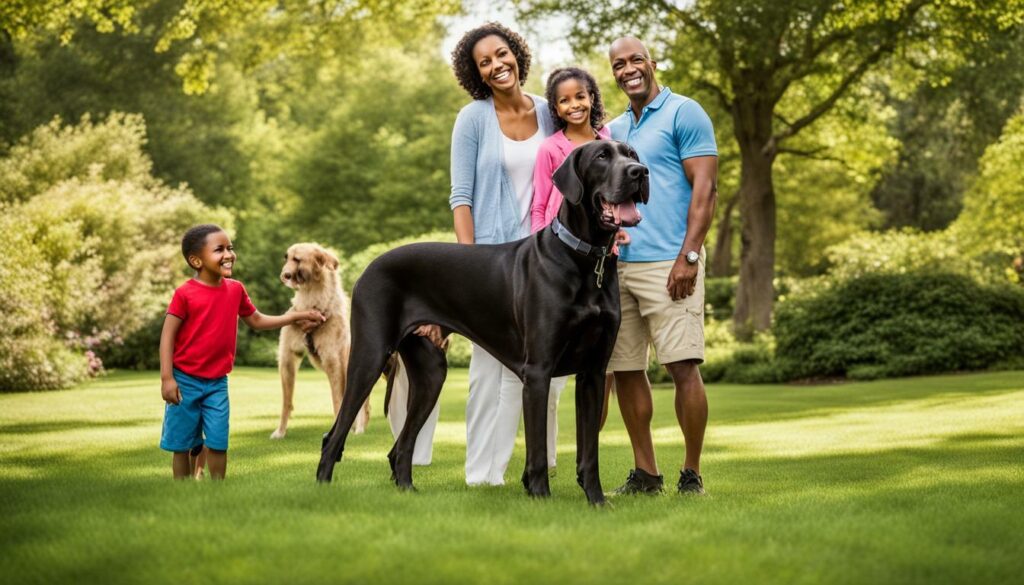
When it comes to caring for your Great Dane, there are a few essentials that you should keep in mind. From grooming to feeding to creating a safe environment, these tips will help you provide the best care for your gentle giant.
Grooming
Grooming is an essential part of caring for your Great Dane. Regular brushing can help remove loose hair and prevent matting. Use a slicker brush or comb to gently work through your dog’s coat. Be sure to pay attention to any tangles or mats, and gently work them out with your fingers or a dematting tool.
Bathing should be done as needed. Great Danes have sensitive skin, so use a gentle shampoo designed specifically for dogs. Be sure to rinse thoroughly to avoid any skin irritation. Clean your Great Dane’s ears regularly to prevent infections, and trim their nails every few weeks to prevent them from getting too long.
Feeding
Feeding a Great Dane can be challenging due to their size and nutritional needs. It’s important to choose a high-quality dog food that is specifically formulated for large breeds. Avoid overfeeding, as Great Danes are prone to obesity, which can lead to health problems.
Make sure your Great Dane has access to fresh water at all times. Provide them with a large bowl that is easy to reach, as they enjoy drinking plenty of water.
Safe Environment
Great Danes require a safe and comfortable environment to thrive. Make sure your home is safe for your dog by removing any hazards or dangerous objects. Provide your Great Dane with a comfortable bed and plenty of space to move around. Ensure that your dog has a designated space that is theirs alone, such as a crate or a quiet corner of the house for them to retreat to.
Regular exercise is also essential for your Great Dane’s well-being. These gentle giants require daily exercise to keep them healthy and happy. Be mindful of the amount of exercise your Great Dane gets, as too much can be harmful to their joints.
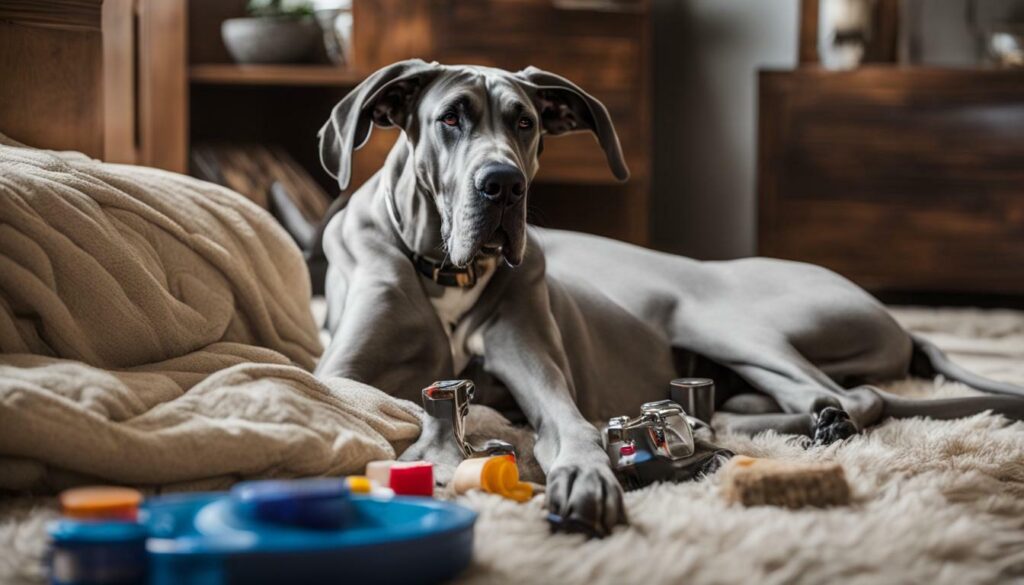
By following these care essentials, you can provide your Great Dane with the best care possible. From grooming to feeding to creating a safe environment, you can ensure that your gentle giant lives a happy and healthy life.
Understanding Great Dane Behavior
Great Danes are known for being gentle giants, but their size can be intimidating to some people. Understanding their behavior is key to developing a positive and well-balanced relationship with your Great Dane.
Typical Behavior and Temperament
Great Danes are generally friendly, outgoing, and good-natured. They love spending time with their owners and are known for being loyal and devoted pets. However, like any breed, individual Great Danes can have their own unique personalities, and it’s important to get to know your dog as an individual.
One characteristic that is typical of Great Danes is their tendency to lean on their owners. They are sometimes referred to as “velcro dogs” because of their desire to be close to their people. They are often happy simply sitting next to you and being petted or cuddled.
Great Danes are also known for their sensitivity, both to their surroundings and to their owners’ moods. They can pick up on changes in their environment and may become anxious if there are too many unfamiliar people or noises. They are also very intuitive and can sense when their owners are upset or stressed.
Lastly, it’s important to note that Great Danes are generally not aggressive or territorial. While they may bark to alert you to strangers, they are not typically protective in the way that some other breeds are. They are more likely to be friendly and curious than aggressive.
Interpreting Body Language
Like all dogs, Great Danes communicate with body language. Understanding what your dog is trying to tell you can help you provide the best possible care and prevent behavioral issues from developing.
Some common body language cues that Great Danes may exhibit include:
| Cue | Meaning |
|---|---|
| Tail held high and wagging slowly | Happy and relaxed |
| Tail tucked between legs | Fearful or anxious |
| Ears pinned back | Nervous or frightened |
| Growling or baring teeth | Aggressive or defensive |
Common Behavioral Issues
While Great Danes are generally well-behaved and easy to train, there are a few behavioral issues that owners should be aware of:
- Boredom and destructiveness: Great Danes are intelligent dogs that need mental stimulation, or they can become bored and destructive. Providing plenty of exercise and puzzle toys can help prevent these issues.
- Separation anxiety: Great Danes are sensitive dogs that can become anxious if they are left alone for too long. Gradually increasing the amount of time that your dog spends away from you can help prevent separation anxiety.
- Jumping up: Because they are so big, Great Danes can easily knock people over by jumping up. Training your dog to greet people calmly and politely can help prevent this behavior.
By understanding your Great Dane’s behavior and needs, you can help ensure that they are happy, healthy, and well-behaved members of your family.
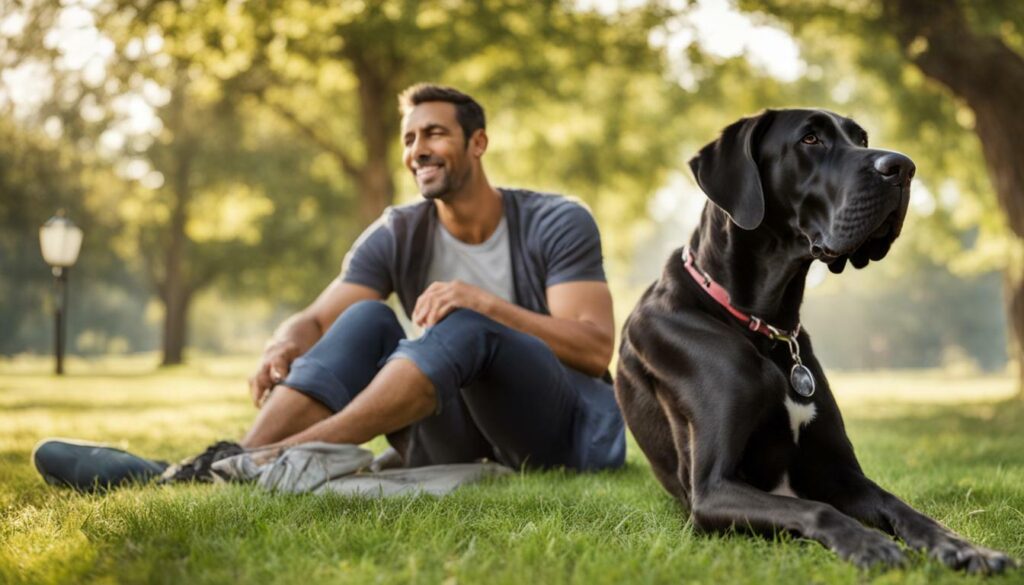
Great Danes have specific health and nutrition requirements that owners must be aware of to ensure their overall well-being. Proper nutrition plays a significant role in your Great Dane’s health and lifespan. Feeding your dog a well-balanced diet consisting of high-quality proteins, fats, and carbohydrates is essential.
When choosing food for your Great Dane, avoid pet food brands that contain fillers such as corn, wheat, and soy. These ingredients can cause digestive problems and allergic reactions in Great Danes. Instead, look for dog foods that list high-quality meats as the primary ingredients. Great Dane puppies require food that has a protein content of at least 25%, while adult Great Danes need protein levels of around 18%.
Overfeeding your Great Dane can lead to obesity, which can increase the risk of certain health issues such as hip dysplasia, heart problems, and respiratory issues. Therefore, it is crucial to monitor your Great Dane’s food intake and provide them with regular exercise to maintain a healthy weight.
Preventive Care
Preventive care is an essential component of maintaining your Great Dane’s health. Regular veterinary check-ups are vital to detect and treat health problems early on. As Great Danes are prone to hip dysplasia, regular hip x-rays are recommended to detect this condition early and reduce the impact of joint problems.
It is also important to ensure that your Great Dane is up-to-date on all of their vaccinations and disease preventatives. Heartworm and flea/tick preventatives are essential for Great Danes as they are susceptible to heartworm disease, tick-borne diseases, and flea infestations. Your veterinarian can advise you on the necessary vaccines and preventive measures based on your Great Dane’s health history and lifestyle.
Common Health Conditions
Great Danes are prone to several health conditions, including hip dysplasia, bloat, dilated cardiomyopathy, and osteosarcoma. These conditions can be managed with proper nutrition, exercise, and regular veterinary check-ups.
Bloat is a severe and potentially life-threatening condition that can affect Great Danes. It occurs when the stomach fills with gas or fluid and twists on itself, causing a blockage. Feeding your Great Dane smaller, frequent meals and avoiding exercise immediately after eating can help reduce the risk of bloat.
Osteosarcoma is a type of bone cancer that commonly affects Great Danes. Early detection and treatment are crucial for managing the condition. Treatment options may include surgery, chemotherapy, and radiation therapy, depending on the severity of the cancer.
Proper nutrition, preventive care, and regular veterinary check-ups are essential for maintaining your Great Dane’s health and well-being. By providing them with the necessary care and attention, you can ensure that your Great Dane lives a long and healthy life.
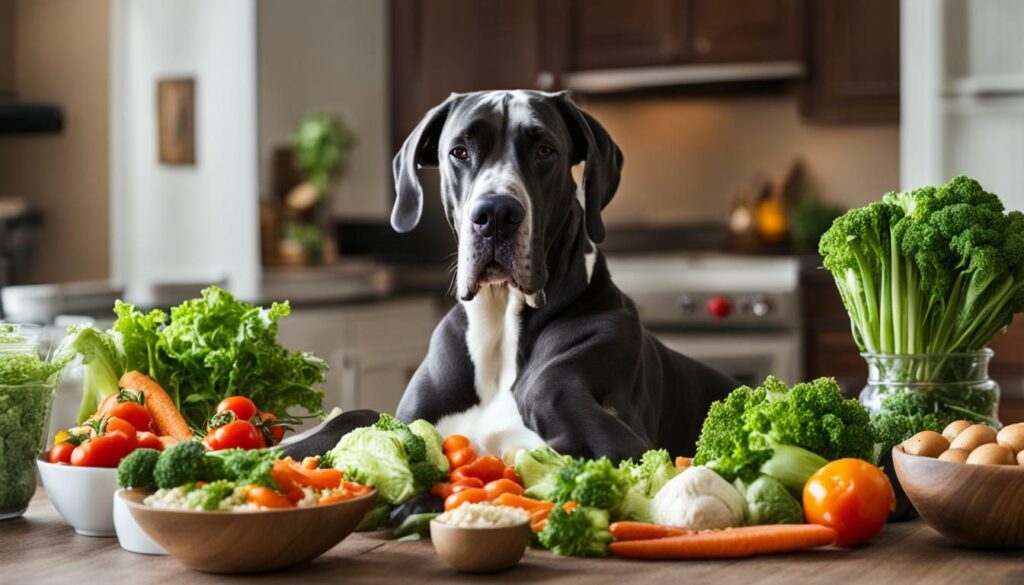
Training a Great Dane requires a combination of consistency, patience, and positive reinforcement. These gentle giants are intelligent and eager to please, making them highly trainable with the right approach.
Start Early
Start training your Great Dane as early as possible. This will help establish good behaviors before bad habits set in. Remember that Great Danes grow rapidly, so it’s important to teach them early on how to behave around people, other animals, and in different environments.
Positive Reinforcement
Use positive reinforcement techniques, such as rewards and praise, to encourage good behavior. This can include treats, toys, or verbal praise. Avoid using punishment or aggression, as this can cause fear and anxiety in your Great Dane.
Keep Training Sessions Short
Great Danes have short attention spans, so keep your training sessions short and focused. Aim for several short sessions throughout the day rather than one long session. This will help keep your Great Dane engaged and interested in the training process.
Be Consistent
Consistency is key when training your Great Dane. Use the same commands and stick to the same rules to help reinforce good behavior. This will help your Great Dane understand what is expected of them and make training more effective.
Gradual Socialization
Gradual socialization is important for Great Danes, as they can be wary of unfamiliar people and animals. Introduce your Great Dane to new people and animals slowly and in a controlled environment. This will help them feel more comfortable and confident in different situations.
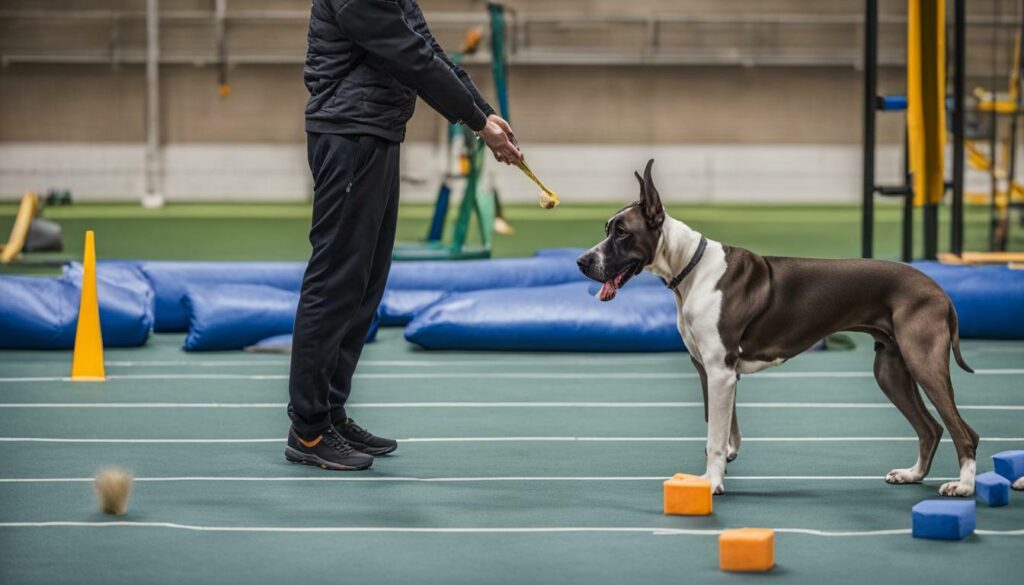
Training a Great Dane takes time and patience. Don’t get discouraged if progress is slow or your Great Dane seems to be struggling. With consistent effort and positive reinforcement, you can train your Great Dane to be a well-behaved and obedient companion.
By following these techniques, you can establish a strong bond with your Great Dane and help them reach their full potential.
Great Dane Grooming Tips
Grooming a Great Dane is essential for their overall health and well-being. Here are some tips to help keep your Great Dane looking and feeling their best:
| Grooming Task | Frequency |
|---|---|
| Brushing | Once a week |
| Bathing | Every 2-3 months or as needed |
| Nail trimming | Every 2-3 months or as needed |
| Ear cleaning | Once a month or as needed |
Brushing: Great Danes have a short, smooth coat that doesn’t require much maintenance. However, regular brushing helps distribute natural oils and remove loose fur and debris. Use a soft-bristled brush or grooming mitt to gently brush your Great Dane once a week. Be sure to pay attention to areas prone to matting, such as behind the ears and under the legs.
Bathing: Great Danes don’t need frequent baths unless they get particularly dirty or smelly. Use a mild dog shampoo and rinse thoroughly to avoid skin irritation. Regular bathing can help prevent skin infections and promote healthy coat growth.
Nail trimming: Great Danes have large, strong nails that can become overgrown and cause discomfort if not trimmed regularly. Use a clipper designed for dogs and trim the tips of the nails, being careful not to cut the quick (the pink area inside the nail). If you’re unsure how to trim your Great Dane’s nails, ask your vet or a professional groomer for help.
Ear cleaning: Great Danes have floppy ears that can trap moisture and debris, leading to ear infections. Clean your Great Dane’s ears once a month or as needed with a vet-approved ear cleaner and cotton balls or pads. Gently wipe the inside of the ears, being careful not to go too deep.
Regular grooming can help keep your Great Dane healthy and happy. If you’re unsure how to groom your Great Dane or have any questions about their grooming needs, consult with your vet or a professional groomer.
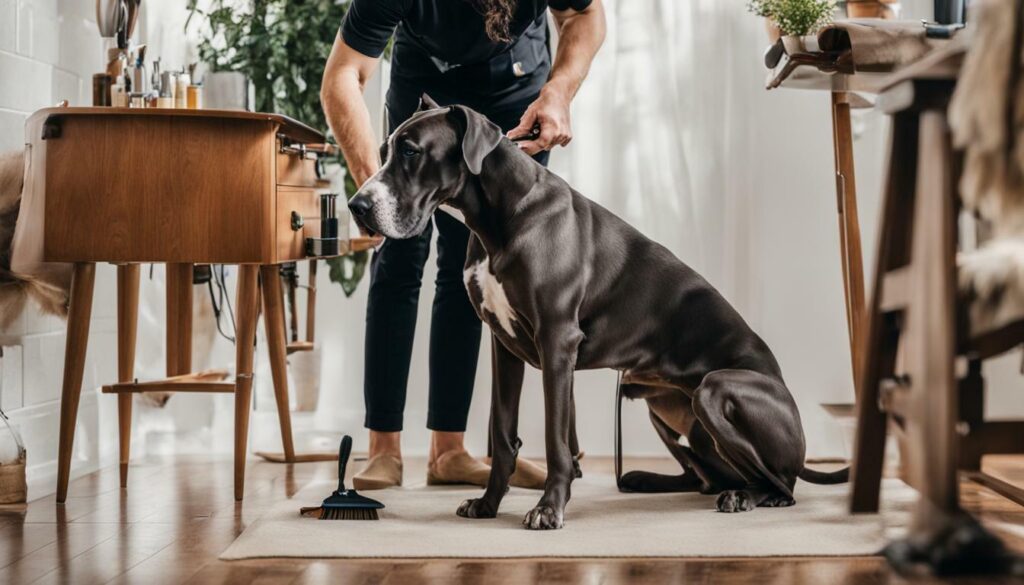
Great Danes are gentle giants with specific needs that require responsible ownership. Here are some best practices to ensure that your Great Dane is happy, healthy, and well-behaved:
Socialization
Introduce your Great Dane to a variety of people, animals, and environments to help them develop positive behaviors and become well-adjusted. Start socializing your Great Dane as early as possible, but remember that it’s never too late to start. Expose them to different sights, sounds, and smells, and reward them for good behavior. Socialization is key to preventing behavioral issues later on, such as aggression and anxiety.
Exercise Routines
Great Danes are large dogs that require regular exercise to maintain their physical and mental health. Create a suitable exercise routine that meets your Great Dane’s needs, but be mindful of their joints, as they are prone to joint problems. Take them for walks, play fetch, or go for a swim to keep them active and engaged. Daily exercise is essential for preventing obesity and promoting a healthy lifestyle.
Providing Mental Stimulation
Great Danes are intelligent dogs that require mental stimulation to stay happy and engaged. Provide them with toys and puzzles that challenge their minds, and consider obedience training or agility courses to keep their minds active. Mental stimulation is essential for preventing boredom and destructive behaviors, such as chewing or digging.
Safe and Comfortable Living Environment
Great Danes need a safe and comfortable living environment that meets their physical and emotional needs. Provide them with a comfortable bed, access to fresh water, and a healthy diet. Ensure that your home is free from hazards, such as toxic plants or small objects that your Great Dane could swallow. A safe and comfortable living environment is important for promoting a happy and healthy life.
Regular Vet Check-ups
Great Danes are prone to certain health conditions, such as hip dysplasia and bloat. Schedule regular check-ups with your vet to ensure that your Great Dane is healthy and up-to-date on vaccinations. Early detection and treatment of health issues can prevent them from becoming more serious and costly later on.
By following these best practices, you can ensure that your Great Dane is a happy, well-behaved, and healthy companion for years to come.
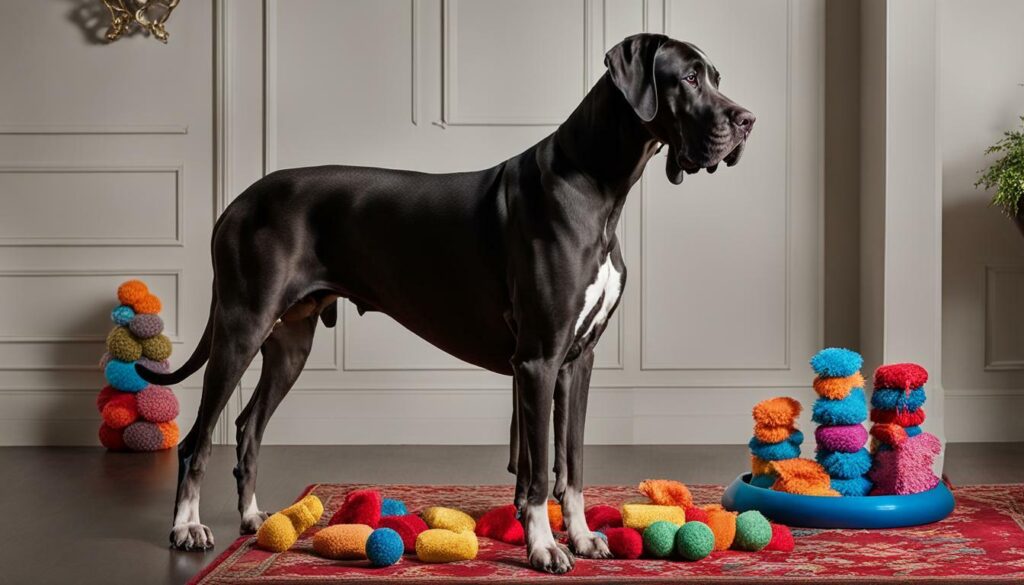
Great Danes may have a calm demeanor, but they still require regular exercise to maintain their physical and mental health. As a large breed, they need plenty of space to move around and stretch their legs, so an apartment or small home may not be the best environment for them.
It’s recommended that Great Danes get at least 30 minutes of moderate exercise per day, but they can handle more if you’re up for it! Their exercise routine should include a mix of physical activity and mental stimulation to keep them engaged and prevent boredom.
One form of exercise that Great Danes love is walking. They enjoy exploring their surroundings, and it’s an excellent way to bond with your pet while providing them with the physical activity they need.
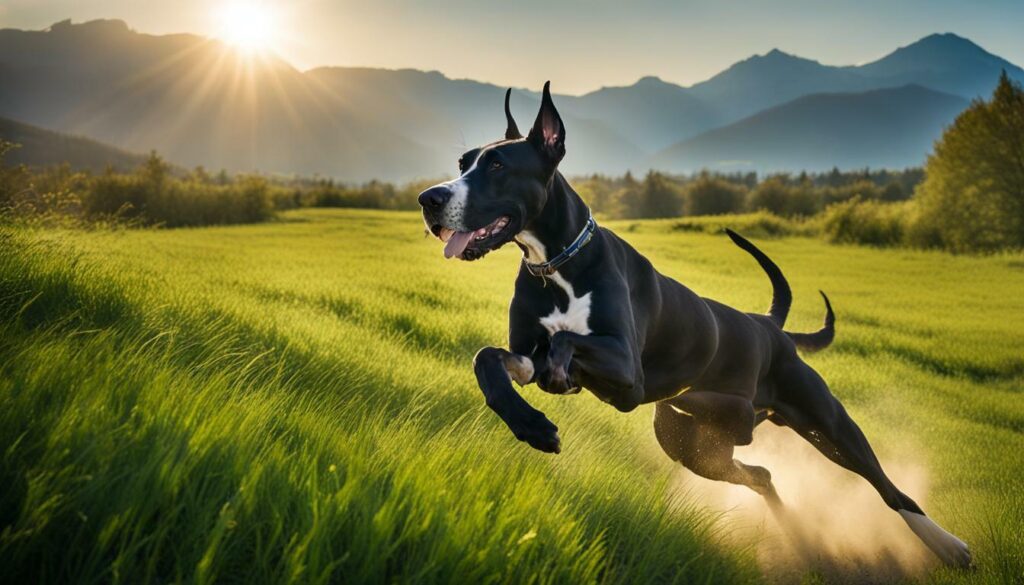
Great Danes also enjoy playing games, such as fetch and tug-of-war. Just make sure to play safely and avoid any roughhousing that could cause injury.
Swimming is another excellent exercise option for Great Danes. Their large size and powerful legs make them natural swimmers, and it’s a low-impact activity that’s easy on their joints.
Remember that Great Danes are prone to hip dysplasia and other joint issues, so it’s important to choose exercises that won’t put too much strain on their joints. Avoid jumping and high-impact activities that could worsen these conditions.
In conclusion, Great Danes require moderate exercise to maintain good health. Walking, playing games, and swimming are all excellent options to keep your Great Dane active and happy. Just make sure to choose activities that are safe and appropriate for their size and physical condition.
Great Dane Training Tips
Training a Great Dane requires patience, consistency, and a firm yet gentle approach. These gentle giants are intelligent and eager to please, but they can also be stubborn at times. Here are some effective training tips to help you train your Great Dane:
1. Start Early
Begin training your Great Dane as early as possible. This will help them develop good habits and prevent bad behaviors from becoming ingrained. Use positive reinforcement techniques, such as treats, praise, and playtime, to encourage good behavior.
2. Be Consistent
Consistency is key when training a Great Dane. Use the same commands and rewards every time, and be patient with your dog if they don’t get it right away. Avoid using physical punishment or yelling, as this can damage your relationship with your dog.
3. Socialize Your Great Dane
Great Danes are social animals and need to be socialized from an early age. Expose your dog to different people, animals, and environments to help them become well-adjusted and confident. This will also help prevent aggression and anxiety.
4. Use Positive Reinforcement
Positive reinforcement is the most effective training technique for Great Danes. Use treats, praise, and playtime to reinforce good behavior. Avoid using punishment or negative reinforcement, as this can damage your dog’s trust and confidence.
5. Be Patient
Training a Great Dane takes time and patience. Don’t expect your dog to learn everything overnight, and be prepared to repeat commands and exercises many times. Celebrate small victories and be consistent with your training routines.
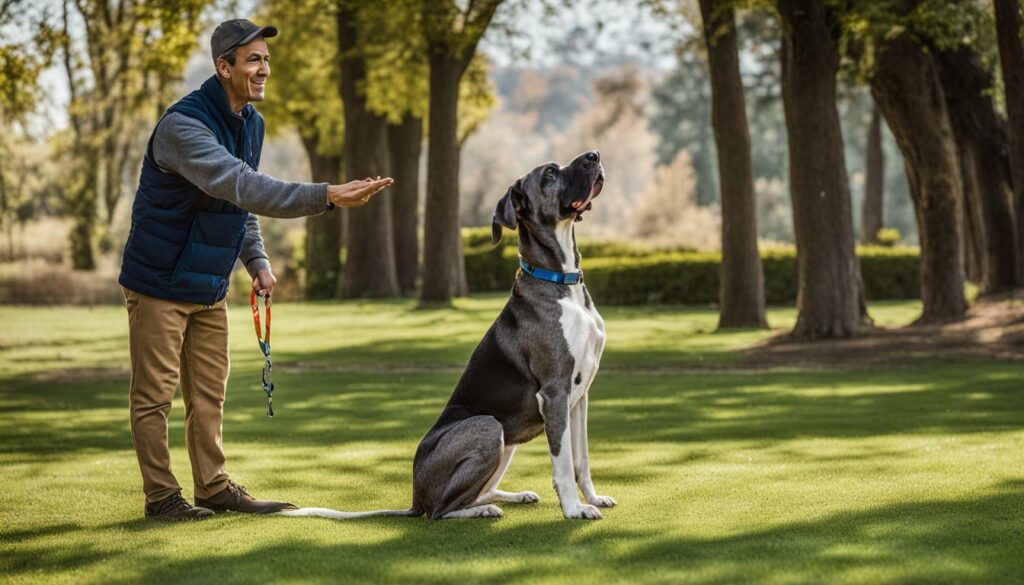
By following these training tips, you can help your Great Dane become a well-behaved and obedient companion. With patience, consistency, and positive reinforcement, you can build a strong bond with your gentle giant that will last a lifetime.
Conclusion
As you wrap up this Great Dane ownership guide, you should have a better understanding of what it takes to be a responsible and loving owner to your gentle giant. By choosing the right breed, providing proper care, nutrition, and exercise, and training your Great Dane effectively, you can create a wonderful and fulfilling life with your furry companion.
Remember, owning a Great Dane requires patience, dedication, and a willingness to learn. By following the best practices outlined in this guide, you can establish a strong bond with your dog that will last a lifetime.
Thank you for choosing Great Dane ownership!
FAQ
Q: Why should I choose a Great Dane as my pet?
A: Great Danes make excellent pets due to their gentle and friendly nature. They are great with families and can be a loyal and loving companion.
Q: What are the care essentials for Great Danes?
A: Great Dane care essentials include regular grooming, proper feeding, and creating a safe living environment. Maintaining their coat, nails, and dental health is important, as well as providing them with suitable exercise.
Q: How can I understand Great Dane behavior?
A: Understanding Great Dane behavior involves learning to interpret their body language, addressing common behavioral issues, and fostering a positive and well-balanced relationship with your dog.
Q: What are the specific health and nutrition needs of Great Danes?
A: Great Danes have specific health needs, including preventive care for common conditions and a balanced diet to support their growth and overall well-being.
Q: Are there any training techniques specifically for Great Danes?
A: Yes, there are training techniques tailored to the needs of Great Danes. These techniques can help you teach basic commands, address behavioral issues, and socialize your dog effectively.
Q: How can I groom my Great Dane effectively?
A: Proper grooming for Great Danes includes regular bathing, brushing, and ear cleaning. It is important to maintain their coat’s health and hygiene.
Q: What are the best practices for owning a Great Dane?
A: Best practices for Great Dane ownership include socialization, creating a safe home environment, and providing mental and physical stimulation to meet their needs.
Q: How much exercise do Great Danes require?
A: Great Danes require regular exercise to stay happy and healthy. It is important to provide them with suitable activities that meet their energy levels and promote overall well-being.
Q: Do you have any training tips for Great Danes?
A: Yes, training tips for Great Danes include basic obedience training, leash manners, and advanced commands. These tips can help you train your Great Dane effectively and build a strong bond.
Q: What should I take away from this Great Dane ownership guide?
A: This guide provides essential information on Great Dane ownership, covering aspects such as choosing the right breed, understanding their behavior, health and nutrition needs, grooming, training, and best practices for responsible ownership.
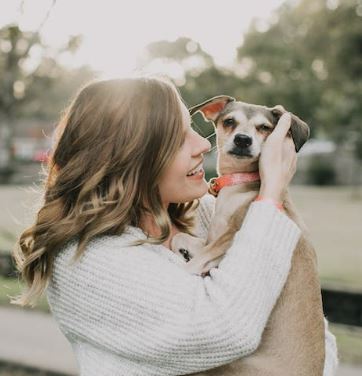
Marissa Delotta, 36, from Dayton, Ohio, is the creative force behind Roverboard.com, a beloved online destination for dog lovers. As a dedicated mom and canine enthusiast, Marissa combines her family experiences with her love for dogs to offer a platform where dog owners can exchange tips, heartwarming stories, and advice. Her website has become a vibrant community for sharing the joys of dog parenting. In her free time, Marissa enjoys exploring dog parks with her family and volunteering at local animal shelters.